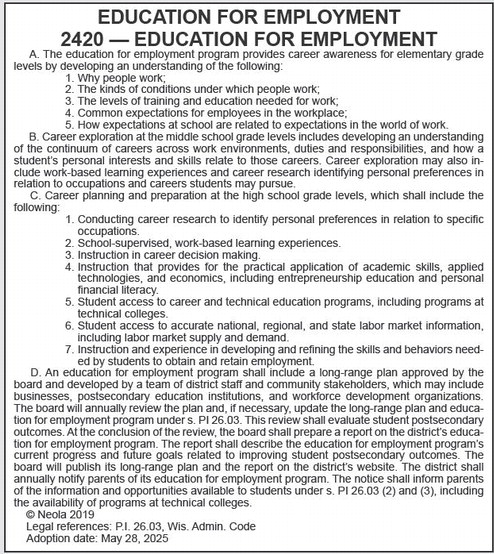Posted on July 29, 2025 recordgleaner_20250730_trg-2025-07-30-0-023_art_1.xml
EDUCATION FOR EMPLOYMENT 2420 — EDUCATION FOR EMPLOYMENT A. The education for employment program provides career awareness for elementary grade levels by developing an understanding of the following: 1. Why people work; 2. The kinds of conditions under which people work; 3. The levels of training and education needed for work; 4. Common expectations for employees in the workplace; 5. How expectations at school are related to expectations in the world of work. B. Career exploration at the middle school grade levels includes developing an understanding of the continuum of careers across work environments, duties and responsibilities, and how a student’s personal interests and skills relate to those careers. Career exploration may also include work-based learning experiences and career research identifying personal preferences in relation to occupations and careers students may pursue. C. Career planning and preparation at the high school grade levels, which shall include the following: 1. Conducting career research to identify personal preferences in relation to specific occupations. 2. School-supervised, work-based learning experiences. 3. Instruction in career decision making. 4. Instruction that provides for the practical application of academic skills, applied technologies, and economics, including entrepreneurship education and personal financial literacy. 5. Student access to career and technical education programs, including programs at technical colleges. 6. Student access to accurate national, regional, and state labor market information, including labor market supply and demand. 7. Instruction and experience in developing and refining the skills and behaviors needed by students to obtain and retain employment. D. An education for employment program shall include a long-range plan approved by the board and developed by a team of district staff and community stakeholders, which may include businesses, postsecondary education institutions, and workforce development organizations. The board will annually review the plan and, if necessary, update the long-range plan and education for employment program under s. PI 26.03. This review shall evaluate student postsecondary outcomes. At the conclusion of the review, the board shall prepare a report on the district’s education for employment program. The report shall describe the education for employment program’s current progress and future goals related to improving student postsecondary outcomes. The board will publish its long-range plan and the report on the district’s website. The district shall annually notify parents of its education for employment program. The notice shall inform parents of the information and opportunities available to students under s. PI 26.03 (2) and (3), including the availability of programs at technical colleges. © Neola 2019 Legal references: P.I. 26.03, Wis. Admin. Code Adoption date: May 28, 2025 EDUCATION FOR EMPLOYMENT 2420 — EDUCATION FOR EMPLOYMENT A. The education for employment program provides career awareness for elementary grade levels by developing an understanding of the following: 1. Why people work; 2. The kinds of conditions under which people work; 3. The levels of training and education needed for work; 4. Common expectations for employees in the workplace; 5. How expectations at school are related to expectations in the world of work. B. Career exploration at the middle school grade levels includes developing an understanding of the continuum of careers across work environments, duties and responsibilities, and how a student’s personal interests and skills relate to those careers. Career exploration may also include work-based learning experiences and career research identifying personal preferences in relation to occupations and careers students may pursue. C. Career planning and preparation at the high school grade levels, which shall include the following: 1. Conducting career research to identify personal preferences in relation to specific occupations. 2. School-supervised, work-based learning experiences. 3. Instruction in career decision making. 4. Instruction that provides for the practical application of academic skills, applied technologies, and economics, including entrepreneurship education and personal financial literacy. 5. Student access to career and technical education programs, including programs at technical colleges. 6. Student access to accurate national, regional, and state labor market information, including labor market supply and demand. 7. Instruction and experience in developing and refining the skills and behaviors needed by students to obtain and retain employment. D. An education for employment program shall include a long-range plan approved by the board and developed by a team of district staff and community stakeholders, which may include businesses, postsecondary education institutions, and workforce development organizations. The board will annually review the plan and, if necessary, update the long-range plan and education for employment program under s. PI 26.03. This review shall evaluate student postsecondary outcomes. At the conclusion of the review, the board shall prepare a report on the district’s education for employment program. The report shall describe the education for employment program’s current progress and future goals related to improving student postsecondary outcomes. The board will publish its long-range plan and the report on the district’s website. The district shall annually notify parents of its education for employment program. The notice shall inform parents of the information and opportunities available to students under s. PI 26.03 (2) and (3), including the availability of programs at technical colleges. © Neola 2019 Legal references: P.I. 26.03, Wis. Admin. Code Adoption date: May 28, 2025
We use cookies to ensure that we give you the best experience on our website. If you continue to use this site we will assume that you are happy with it. Ok



